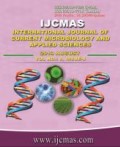


 National Academy of Agricultural Sciences (NAAS)
National Academy of Agricultural Sciences (NAAS)

|
PRINT ISSN : 2319-7692
Online ISSN : 2319-7706 Issues : 12 per year Publisher : Excellent Publishers Email : editorijcmas@gmail.com / submit@ijcmas.com Editor-in-chief: Dr.M.Prakash Index Copernicus ICV 2018: 95.39 NAAS RATING 2020: 5.38 |
The field experiment was conducted during summer season of 2018 at the Bagusala Farm of MS Swaminathan School of Agriculture, Centurion University of Technology and Management, Gajapathi district, Paralakhemundi, Odisha (84.18’N longitude and 18.80’ E latitude). The mean minimum and maximum temperatures were 210C and 310C respectively. The soil at the experimental site is sandy loam in texture. The soil is slightly acidic in reaction (6.2), normal in electrical conductivity, low in organic carbon (0.41%), available nitrogen is 76.2 kg/ha, with 21.3 kg/ha of available phosphorus and 126.2 kg/ha of available potassium. The experiment was laid out in a Factorial Randomized Block Design with 12-treatment combinations in 3 replications. The first factor was comprised of three levels of sprayings: S1= no spraying; S2= single spraying at 25 days after sowing (DAS) i.e. at vegetative stage; S3= double spraying, one at 25 DAS (vegetative stage) another at reproductive stage 50 DAS at full flowering and the second factor was four phosphorous levels, that is 20 kg P2O5/ ha; 40 kg P2O5/ ha; 60 kg P2O5/ ha and 80 kg P2O5/ ha. Seeds are sown at a depth of about 3 cm as per layout plan at a row to row distance of 30 cm and 10 cm distance amongst plants was maintained in row. Prior to sowing after final land preparation and layout, the fertilizers were supplied as FYM @ 10 t/ha and N and K2O were applied @ 20 Kg/ha each in the form of urea and MOP, respectively. Phosphatic fertilizers as per treatments were applied in the form of SSP in accordance with treatments. Irrespective of phosphorous application the double spray of antitranspirant gave highest plant height (27.5 cm), Dry matter accumulation (297.67 cm), Leaf area index (1.61) and grain yield of (865.6 kg/ha) The application of phosphorous@80 kg/ha had shown maximum number of pods per plant (15.96), highest stover yield of (2059.76 kg/ha) along with maximum test weight (2.50 g) and harvest index (29.63). The double spray of anti transpirant along with 80 kg/ha had got highest net return and B: C ratio of 1.23.
 |
 |
 |
 |
 |